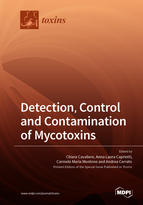Detection, Control and Contamination of Mycotoxins
A special issue of Toxins (ISSN 2072-6651). This special issue belongs to the section "Mycotoxins".
Deadline for manuscript submissions: closed (20 August 2022) | Viewed by 39205
Special Issue Editors
Interests: liquid chromatography–mass spectrometry; mycotoxins; environmental contaminants; food contaminants; polyphenols; sample preparation; metabolomics; peptidomics; bioactive peptides
Special Issues, Collections and Topics in MDPI journals
Interests: high-resolution mass spectrometry; hyphenated techniques; omics sciences; proteomics; peptidomics; food analysis
Special Issues, Collections and Topics in MDPI journals
Interests: proteomics; peptidomics; protein extraction and purification; bioactive peptide analysis; method development and validation; lipidomics
Special Issues, Collections and Topics in MDPI journals
Interests: high-resolution mass spectrometry; hyphenated techniques; omics sciences; metabolomics; lipidomics; food analysis
Special Issues, Collections and Topics in MDPI journals
Special Issue Information
Dear Colleagues,
I would like to invite you to contribute to this Special Issue focused on “Detection, Control and Contamination of Mycotoxins”.
The objective of this collection is to illustrate the most recent research on the development of novel and/or rapid methods for mycotoxin determination, and to propose new strategies for monitoring and/or reducing mycotoxin contamination. Innovative sample preparation techniques or protocols and the possibility of multiclass mycotoxin detection will be very positively considered for possible inclusion in this Special Issue. Both methods based on (bio)sensors and chromatography with various detectors (including mass spectrometry) are welcome. Applications of already published methods on new matrices without any modification will not be accepted. However, extensive studies and monitoring on the spread of contamination through the food production chain could be of interest for this collection.
This Special Issue is intended not only for an expert scientific readership, but also for researchers that are just starting to work in the field of mycotoxins. Indeed, we hope that it will represent a new and exciting overview for the scientific community, and that it will inspire young researchers.
Prof. Dr. Chiara Cavaliere
Prof. Dr. Anna Laura Capriotti
Dr. Carmela Maria Montone
Dr. Andrea Cerrato
Guest Editors
Manuscript Submission Information
Manuscripts should be submitted online at www.mdpi.com by registering and logging in to this website. Once you are registered, click here to go to the submission form. Manuscripts can be submitted until the deadline. All submissions that pass pre-check are peer-reviewed. Accepted papers will be published continuously in the journal (as soon as accepted) and will be listed together on the special issue website. Research articles, review articles as well as short communications are invited. For planned papers, a title and short abstract (about 100 words) can be sent to the Editorial Office for announcement on this website.
Submitted manuscripts should not have been published previously, nor be under consideration for publication elsewhere (except conference proceedings papers). All manuscripts are thoroughly refereed through a double-blind peer-review process. A guide for authors and other relevant information for submission of manuscripts is available on the Instructions for Authors page. Toxins is an international peer-reviewed open access monthly journal published by MDPI.
Please visit the Instructions for Authors page before submitting a manuscript. The Article Processing Charge (APC) for publication in this open access journal is 2700 CHF (Swiss Francs). Submitted papers should be well formatted and use good English. Authors may use MDPI's English editing service prior to publication or during author revisions.
Keywords
- mycotoxins
- sensors
- liquid chromatography
- gas chromatography
- sample preparation
- food safety
- food production chain
- multi-mycotoxin determination
Related Special Issue
- Detection, Control and Contamination of Mycotoxins (Volume II) in Toxins (11 articles)









